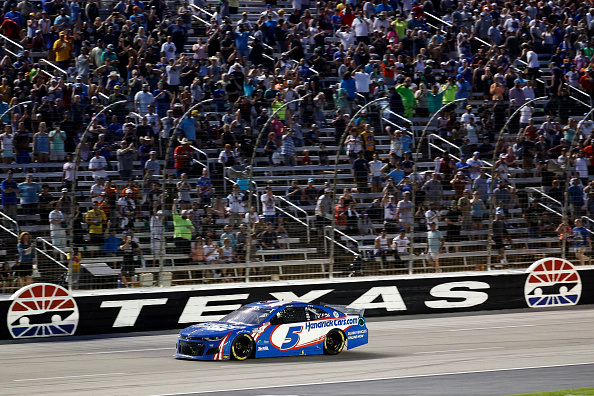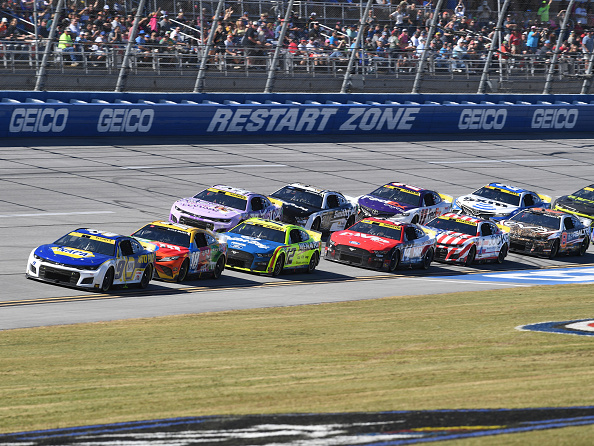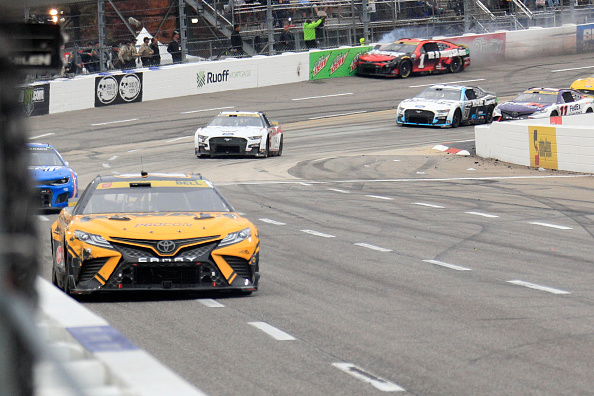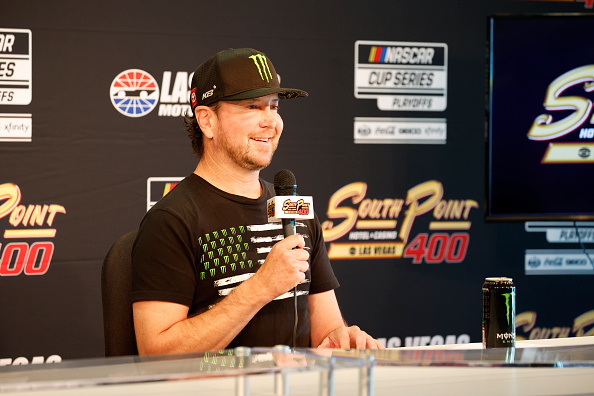The sanctioning body of NASCAR has made near wholesale changes in recent years. They have ranged from car packages and race stages to playoff formatting and track additions/subtractions on the schedule. Despite these efforts, NASCAR still finds itself in a spot of needing improvement, especially with the Gen-7 Car set to roll into the Cup Series next year.
Before this season began, they touted an ad campaign claiming this would be “The Best Season Ever”. At the halfway point of this year, this season has been okay at best and mediocre at worst. Earlier on Tuesday, the great Jeff Gluck posed this question on Twitter with the overall dissatisfaction of late.
There's a lot of unhappiness on NASCAR Twitter lately. Just curious: What, if anything, could NASCAR do to make you happier?
— Jeff Gluck (@jeff_gluck) June 15, 2021
With that question in mind, here are ten things (in no particular order) that I would immediately change about NASCAR.
Race Length Reduction for Cup Series
One of the biggest problems that the NASCAR Cup Series currently faces is that most races take far too long. On this year’s schedule, half of the races are set at 400 miles or more, the majority of which are not needed. Of course, there is not an issue with the high-profile races such as the Daytona 500, Coke 600, Southern 500, both Talladega races, and a few others.
However, tracks like Atlanta, Texas, and Kansas (to name a few) having races in the 300-350 mile range would not be the end of the world. With regards to race length more often than not, less is more; one look at most IndyCar and F1 run times can tell you that. If the number of 400-plus mile races can get chopped in half, that would be a much-needed change.
Local/Smaller Tracks in Xfinity and Trucks Series
Tony Stewart and Ray Evernham‘s SRX series kicked off last weekend at the iconic Stafford Motor Speedway in rural Stafford Springs, Connecticut. The field consisted of Stewart, four-time Indianapolis 500 winner Helio Castroneves, Greg Biffle, Tony Kannan, and more. To say that the stands at the track were filled to the brim would be an understatement. It was a fantastic night of racing and the crowd ate up all of the action. With this in mind, why can’t NASCAR do this with the Trucks and Xfinity Series more often?
In fairness to NASCAR, not every small town local track has the infrastructure to host a race. On the other hand, finding around a half dozen or so with that capability would do wonders for the sport. One that immediately pops out is Lucas Oil Raceway, formerly known as Indianapolis Raceway Park. Both series went there regularly for numerous years up until 2011. Xfinity series ended up moving to Indianapolis Motor Speedway a year later, and the Trucks date would be spiritually succeeded by Eldora in 2013.
One would assume more than a dozen local tracks in America would kill to get the Trucks and/Xfinity series to run at their venues. The aforementioned Stafford Motor Speedway would be an intriguing option. Tracks like the Las Vegas Bullring, South Boston, Evergreen Speedway, and countless others, too. Outside of track infrastructure issues and the likely lack of live pit stops, this feels like a no-brainer if those hurdles can be leapt.
Real In-Season Documentary Series
Earlier this year, a Netflix NASCAR show starting Kevin James began its run. To the surprise of no one, its ten-episode first season will be the only ten episodes to see the light of day. This failure is only further compounded by other racing forms putting out top-notch in-season docuseries, including Red Bull’s Moto Spy, MX World, and MX Nation YouTube series in the Motocross/Supercross realm. And of course, the absolute smash hit for Netflix is F1’s Drive to Survive series. Ironically enough, I have friends who could not care less about motorsports talking about how good Drive to Survive is.
NASCAR missing the boat here is all too painfully on-brand. Imagine if there was instant audio/film of Joey Logano and Kyle Busch‘s fight in Las Vegas in the immediate aftermath. Or Jeff Gordon and Brad Keselowski‘s scuffle from Texas in 2014. How about the countless other noteworthy moments NASCAR has had over the last five years alone? Again, this feels like an absolute no-brainer and would do wonders for the sport, if done right.
Eliminate Texas Motor Speedway From All Series
Let’s roll the clocks back to 1996. Braveheart won best picture at the Oscars, the Macarena swept the nation, and Atlanta held the Summer Olympics. All around fantastic stuff. But more importantly, the infamous North Wilkesboro Speedway would host its final then-NASCAR Winston Cup Series race that September. This was in part due to the new 300,000-seat Texas Motor Speedway taking one of its two slots on the schedule. For context, the other slot went towards a second New Hampshire race. On top of the Wilkesboro track not being a big moneymaker compared to others, it also was located in rural North Carolina.
Texas Motor Speedway would have a less-than-stellar christening. It needed last-minute adjustments before its first NASCAR weekend, then went under major renovations in 1997 and 1998. The real issue here comes much later down the road in 2017 when Gossage took turns one and two of his track under the knife. The banking in the first two corners was reduced by four degrees. Also, the width of the turns was increased by 20 feet, from 60 to 80. In short, these changes made Texas one of the biggest eyesores in all of NASCAR.
The quality of racing has taken an absolute nosedive and the crowds on race days reflect that. A venue that hosts over a quarter of a million people brings in about a fourth of that amount by the looks of it. To further cement this point, track GM Kenton Nelson on Wednesday revealed that the seating would be gutted to around 75,000.
With the good ol’ boys’ club of Speedway Motorsports Inc. owning the track, this eliminating the venue is likely a pipe dream. Quite honestly, however, it should be done. They would just need to find the proper amount of TNT for TMS first.
Cut Season Length and Eliminate Playoffs.
These two changes go hand in hand, so they are together. For what it is worth, a playoff/chase in a 36 race season is fine. I would rather not see, for instance, Kyle Larson clinch the title seven rounds early if there were no playoffs. That renders the final few races of the season pointless. But in regards to how long NASCAR runs, there is no real good reason for it to go from February to late November. Not even bringing up that almost all of the playoffs are going head-to-head with the NFL. A recipe for disaster for ratings and fan interest, despite what some denialistic fans may think/say.
A season that lasts from late February and then ends on Labor Day weekend would be about as picture-perfect as it gets. This would allow the Southern 500 to be the season finale, which I would imagine would not likely face resistance. Also, given that this would hypothetically slash the current 36 race Cup Series tilt by around a third or more, playoffs would no longer be needed. Some tracks potentially could lose dates with this move. However, with the number of mediocre tracks already receiving multiple race dates, this is killing two birds with one stone.
Some tracks only receiving one race date per year would make those races instantly more important, knowing that there is not another one months down the road. A season ranging in the 24-30 race range over a seven-month span would be a sweet spot of it not dragging on for too long. NASCAR would also still have enough races to keep things interesting.
Double Headers and Residencies
This point somewhat tags along with the previous two, but not as much. This year in the Monster Energy Supercross series, events would be held at the same venue two or three times in the span of seven days. These “Residencies” would take place in Houston, Indianapolis, Orlando, Dallas, Atlanta, and Salt Lake City. NASCAR in 2020 flirted with this concept multiple times, running multiple races in under a week span. This happened at Darlington, Charlotte, Michigan, Pocono, and Dover all in the regular season last year. To spice things up a little, there could be some potential interesting options.
For starters, the opening three races of this season would stick: Daytona 500, Daytona Road Course, and Homestead-Miami. However, they would be run in an either seven- or ten-day span, or perhaps running races on back-to-back nights in Bristol or Richmond. Some short carryover for potential short-track tempers could provide interesting outcomes. Outside of those two, there are plenty of more tantalizing options/combinations. But doing some back-to-backs and residences moving forward would be far from the worst idea the NASCAR sanctioning body has had recently. The mid-week races did not do great in the ratings department in 2020, but a second chance feels warranted.
Putting the Cars Back Into the Hands Of the Drivers
It is no secret that aerodynamics have heavily dictated the on-track product of NASCAR in recent years. The sanctioning body has gone through several package figurations in that span and they are collectively batting below the Mendoza Line. Carl Edwards recently came out of hiding and did a segment on NASCAR: Race Hub. In regards to coming back to racing, he brought up something interesting at the end: “If [NASCAR] changed the package to where there was no downforce and about 1000 horsepower, I’d get pretty interested.”
In 2015, NASCAR implemented a low-downforce package at Kentucky, and it proved to be a solid race. Beginning when the Gen-7 car was unveiled early last month, the horsepower was stated to vary by track, as are the spoiler measurements. Coming off a few consecutive years where racing could have been better, NASCAR has to nail the setup with this new car. Putting it in the hands of the best stock car drivers in the world will go a long way for this new generation being a successful one.
Double Point Races
This is probably the most “out there” change of the 10, but not a new concept in American motorsports. For years, IndyCar has had the Indianapolis 500 series points values doubled. Until recently, the IndyCar season finale did, as well. Having a revamped set of five Crown Jewel races be worth double points would raise the stakes in a solid way. In this scenario, the five races would be the following. The Daytona 500, the Coca-Cola 600, Watkins Glen, Bristol Night Race, and the season-ending Southern 500. Of course, stages and stage points would have to factor in.
Eliminate Stages
Here are some quotes from NASCAR unveiling added stages and stage points to their races back in 2017. Dale Earnhardt Jr: “It’s going to be very interesting to watch these crew chiefs try to figure out the strategies that will help their drivers obtain the most points for each stage, and it’s going to be fun to see how this evolves.” Denny Hamlin: “I think you’re going to see better racing on the racetrack, and that’s all that matters.” And the man that oversaw NASCAR’s empire crumble in the 2000s-2010s, Brian France: “Simply put, this will make our great racing even better.”
Five years in, results have been not the best. In fairness, the concept of stages is not bad. Having a guaranteed set of cautions for unwatchable races gives them a chance to get interesting. Where the really ugly part of stage racing shows up is on Road Course races. Stages outright kill any interesting pit strategies, the two stop runs at Sonoma being an example. The bonus playoff points from winning stages and races are equally as bad. There have been years where drivers have moonwalked through the first two rounds of the playoffs due to earned playoff points.
What is the point of a multi-round playoff when you can basically earn a get-out-of-jail-free card beforehand? IndyCar does not run stages for this reason. The Indianapolis 500 last month had just two cautions the entire race and it was the best race of 2021. F1, V8 Supercars, and MotoGP all seem to be doing just fine without segmented races as well. It is about time NASCAR rejoins them.
Check us out on our socials:
Twitter: @PTSTNews and @TalkPrimeTime
Facebook Page: Prime Time Sports Talk
Join our Facebook Group: Prime Time Sports Talk
Instagram: @ptsportstalk
Follow Jack Gaffney on Twitter @JackGaffneyPTST
Main Image Credit:
Embed from Getty Images








One Response
I agree with a lot of what you said. I’m not a big fan of all Roval racing. No stage racing on road courses. Shortening some of 1.5 races would make the racing better.